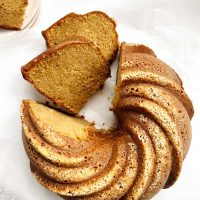
Brown Sugar Toasted Sesame Bundt Cake
This tender, moist bundt cake has caramel-y notes from dark brown sugar and toasted sesame oil, a delicious pairing. The crumb is soft and buttery, with sesame seeds adding just a little bit of crunch.
Servings 10 slices
Ingredients
- 3 cups [426 g] all-purpose flour
- 1/2 teaspoon baking soda
- 1/2 cup [120 g] creme fraiche or sour cream, at room temperature
- 1/2 cup [120 g] whole milk, at room temperature
- 1 1/2 cup [3 sticks or 342 g] unsalted butter, at room temperature
- 2 cups [400 g] dark brown sugar
- 1 cup [200 g] granulated sugar
- 1 1/4 teaspoon salt
- 6 large eggs, at room temperature
- 1 tablespoon toasted sesame oil
- 1 tablespoon pure vanilla extract
- Sesame seeds, for sprinkling, see note
Instructions
- Adjust an oven rack to the middle position and preheat the oven to 350°F [180°C]. Generously grease a 12 cup [2.8 L] tube or Bundt pan (see note). Do not use a tube pan with a removable bottom. Sprinkle in sesame seeds if desired (see note again).
- In a medium bowl, whisk together the flour and baking soda.
- In a medium bowl or liquid measuring cup, whisk together the sour cream and whole milk until combined.
- In the bowl of a stand mixer fitted with a paddle, beat the butter on medium speed until creamy, about 1 minute. Add the dark brown and granulated sugars and salt and beat on medium speed until very light and fluffy, 4 to 6 minutes.
- Scrape down the sides of the bowl and add the eggs one at a time, beating on medium speed until incorporated and stopping to scrape down the sides of the bowl after each addition. Add the toasted sesame oil and vanilla and mix on low speed to combine. Add half of the flour mixture and mix on low speed until combined. Add the sour cream mixture and mix on low speed until combined. Scrape down the sides of the bowl, add the remaining flour mixture, and mix on low speed until combined. Increase the speed to medium and beat for 15 to 20 seconds.
- Pour the batter into the prepared pan and use a spatula to even out the top. Bake for 50 to 65 minutes, until a wooden skewer or toothpick inserted near the center comes out clean.
- Transfer the pan to a wire rack and gently run a plastic knife (metal will scratch) around the edge of the cake to loosen it. Let cool for 10 minutes in the pan, then invert the cake onto the rack and remove the pan to finish cooling. The cake can be wrapped in plastic wrap and kept at room temperature for 2 days, or refrigerated for up to 4 days.
Notes
I sprinkled sesame seeds into my Bundt pan after buttering and flouring it, and they all fell into the ridges; I really liked how it looked when flipped. I didn't have any trouble releasing it this way, but sometimes Bundt pans are tricky, so be warned that they could cause the batter to stick if the pan isn't greased properly. You can skip the sesame seeds if you are worried about it.
Use a pastry brush to grease your Bundt pan to get into all the nooks and crannies, including the tube. A baking spray with oil and flour also works. If your cake really is stuck and won't come out, I have found putting it back in the oven for 60 seconds and then instantly flipping it again sometimes works well.
*Throughout my recipes posted on this website, 1 cup of flour equals 142g. Please note that 1 cup of flour can range anywhere from 120g to 142g, depending on the baker or website. I found that after weighting many cups of flour and averaging the total, mine always ended up around this number. If I am posting a recipe from another cookbook, I will use whatever gram measure of flour used in that book, which is why you may see a few posts with a different cup measurement.
Different brands of flour have varying levels of protein, ranging from low to high, which can result in very different outcomes when baking. I’ve found Gold Medal all-purpose unbleached flour to be the best option for many of my recipes; I use it in all the baked goods that don’t use yeast. For yeasted doughs that call for all-purpose flour, I like to use King Arthur Brand. If you are using White Lily flour, please note that it is a low protein flour and doesn’t absorb liquid the same as regular all-purpose flours. Check the back of the flour bag for instructions on substituting it for regular all-purpose flours.